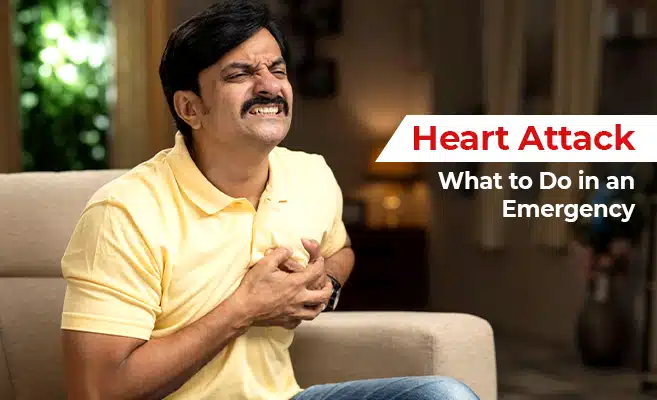Heart Attack: What to Do in an Emergency

With good reason, a lot of individuals are worried about having a heart attack throughout their lifetime. Although heart attacks can be fatal, many individuals do survive them each year. Your chances of surviving a heart attack might be significantly increased by taking a quick action when you feel one coming. A heart attack is an extremely critical medical situation. If you suspect a heart attack to yourself or someone else, dial the local emergency number and perform first aid treatment for heart attack.
An average person waits for three hours before requesting assistance in case of heart attack symptoms. By the time they get to a hospital, many heart attack sufferers pass away. The likelihood of survival increases with the speed at which the patient arrives at the emergency room and follows the first aid treatment for heart attack. The degree of cardiac damage can be reduced with quick medical attention. The steps to take when you believe someone may be experiencing a heart attack are covered in this article.
Understanding the Symptoms
These symptoms differ according to each individual. The abrupt, excruciating chest pain that most of us have heard about does not always signal the start of a heart attack. Some, particularly those that affect diabetics, really have no symptoms at all giving you no time to perform first aid treatment for heart attack.
They could start up gradually and provide just a little pain and discomfort. They can occur when you’re sleeping or exercising. Your age, gender, and underlying health issues might affect how severe they are.
Signs of Concern
Typical examples include
- Chest pain: The most frequent heart attack symptom, it might feel like pressure, squeezing, fullness, or agony that starts in the middle of the chest and lasts for minutes without ceasing, or it can come and go.
- Body aches and pains: During a heart attack, you may experience pain or discomfort in other parts of your body, such as your arms, back, jaw, neck, or stomach.
- Shortness of breath that is unexplained, with or without chest pain
Additional signs comprise
- Frosty sweats
- Vomiting or nauseous
- Lightheadedness
- Stress and indigestion
- Completely baseless tiredness
In addition to their existing conditions, women are more likely to experience discomfort in their upper back, neck, shoulders, or abdomen.
Emergency Procedures
Keep your composure
Loosening tight clothes is the first step for first aid treatment for heart attack. You must sit down, take a break, and make an effort to maintain your composure if you or the person you’re with is experiencing a heart attack.
Call aid
If you think you could be having a heart attack, you or someone else ought to dial the emergency number right away while performing first aid treatment for heart attack.
- Heart attack sufferers can be transported to the hospital considerably faster, if they are taken by emergency personnel rather than others. Since every minute counts, a faster response time at the hospital is another benefit of emergency personnel initiating actions and alerts.
- Additionally, emergency personnel are educated on what to do if a person’s heart stops beating, and they will have the tools and other first aid treatment for heart attack to act on the way to the hospital on board the ambulance.
Chest compressions
It can be necessary to do chest compressions as an act of first aid treatment for heart attack if the individual experiencing a heart attack loses consciousness or if their heart stops beating.
- Lock your hands together and lay them in the middle of their chest, in between the nipples, while you’re kneeling next to them.
- Push downward quickly and forcefully—at least two inches deep—using your entire body, not just your arms.
- Until assistance comes or the patient regains consciousness, keep doing compressions at a rate of 100 to 120 beats per minute.
- To maintain the quality of the compressions if someone else is on the scene, you should take a break after every two minutes.
What not To Do!
- Do not leave the individual alone.
- Perform first aid treatment for heart attack.
- Avoid letting the individual persuade you not to contact for emergency assistance by denying the symptoms.
- Waiting for the symptoms to go away is a bad idea.
- A cardiac medication, such as nitroglycerin, must be given before giving the patient anything to take orally.
What is an Emergency of the Heart?
- Acute heart problems include
- A cardiac arrest.
- A heart attack.
- Undiagnosed chest discomfort that is worsening suddenly or having an angina episode are both examples of unstable angina.
Is it possible to halt a heart attack quickly?
No, there isn’t a quick fix for a heart attack that doesn’t need going to the hospital for emergency care. There are several “fast” heart attack cures available online. These “quick” therapies, however, are ineffective and may even be harmful since they postpone receiving emergency medical care. Only first aid for heart attack India can be beneficial.
Conclusion
Acting soon is crucial if you or someone else is experiencing a heart attack. Waiting for symptoms to go away is not a good idea since every second counts. You may readily receive assistance from PSRI Hospital in identifying any concealed cardiac issues before they become serious. So, schedule your consultation with a best cardiac hospital in Delhi right away to consult with a specialist for you and your loved ones.

 Book An Appointment
Book An Appointment Virtual Consultation
Virtual Consultation




